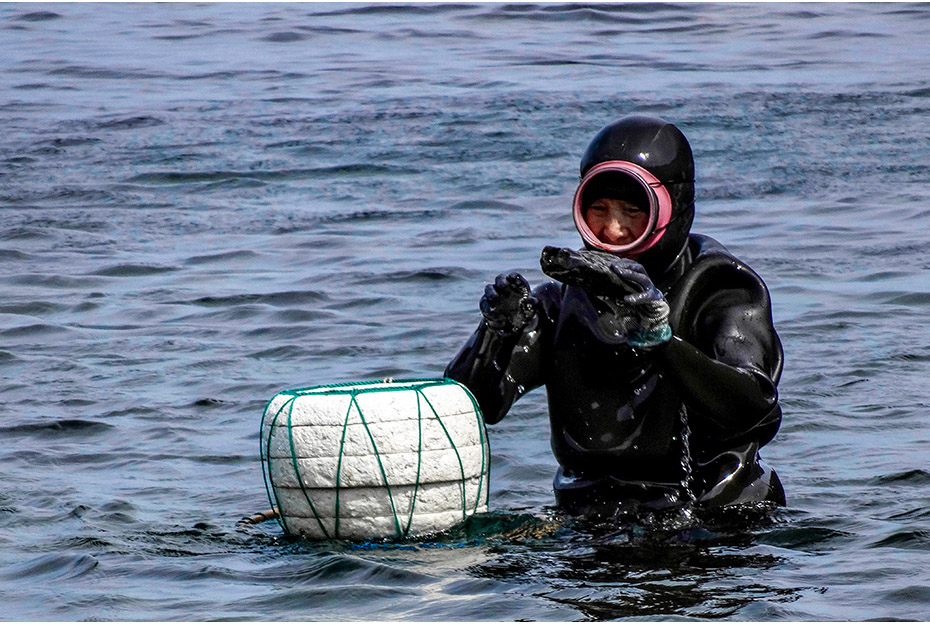Former Researcher, Haenyeo Museum, Republic of Korea
Haenyeo are women divers who presently live only in Korea and Japan where the women from Korea live on Jeju Island, representing the island’s traditional occupations for living. From the viewpoint of marine cultural historians, haenyeo has contributed to the active transmission of diving skills and ecological knowledge including the efficient use of the tide as well as to the establishment of unique haenyeo culture which covers diving suites, tools, folk songs, and shamanic rituals. Haenyeo culture is basically concerned with diving skills that enable women to gather marine products from deep in the sea without the support of any mechanical equipment, it is folk knowledge which has been accumulated through past haenyeo work experience, and the cultural phenomena derived from the sustainability of their livelihood through these means that keeps this heritage alive.
Haenyeo actual diving practice is called muljil, which requires a high level of skill for which they can work fifteen meters deep under the sea while holding her breath for more than one minute. For this ‘superhuman’ diving skill, it is important to control diving time by properly checking the water pressure, oxygen quantity, and the distance to the surface of the sea. They teach that ‘muljil [the difference between the rise and fall of the tide] is a dangerous job for which a haenyeo stakes her own life. She should have little oxygen remaining when she is about to return to the surface. Even when she finds abalone, she should calculate sufficient time for a safe return.’ Thus, haenyeo physical techniques are living skills obtained from her personal work experience.
Full fishery haenyeo folk knowledge includes an extensive understanding of sea geography that is strategically necessary to find a proper fishery spot for the success. A haenyeo instinctively recognizes her working area, where she has found an abundance of marine products by adapting herself to the geography and environment of the sea for a long time. She starts swimming in the sea at age 10 and becomes a professional haenyeo at 16, after she masters all the basic work skills. There are three levels of haenyeo determined by their skill level, and a haenyeo over 30 or 40 years old with full knowledge of sea geography can estimate an area full of marine products, like abalone, and thereby can gather a larger quantity.
The Use of the Tide
The work of haenyeo is usually determined by muljji. In the case of Jeju Island, the best period falls on jo-geum (7th-14th) and yeoseot-mul‘ (23rd-29th) of each lunar month. During these periods, the difference between the rise and fall of the tide is minimized and make the best conditions for diving. She can dive to the exact point that she wants and can easily gather products into a net basket called mangsa-ri with the support of the buoy called te-wak.
Kinds of Marine Products and their Gathering Period
The gathering period for marine products is determined by haenyeo as they try to avoid spawning seasons and consider the marine products ecological traits, which are reflected in the haenyeo knowledge and derived from their work experience. For example, gathering turbines is prohibited from June to September while restrictions on gathering abalone is from October to December.
Community System and the Use of Fishery
A symbol of the haenyeo community is bul-teok, a place surrounded by a stone wall near the seashore which is where they go to change their clothes as well as to avoid the wind. It is the very place used for the exchange of information and knowledge, the reconfirmation of cooperation and the instruction of diving skills among haenyeo.
The fishery regulations laid down by the sea village authority and various shamanic rituals held at the sea god shrine called hae-sin-dang also play an important role in maintaining the haenyeo community as well as regulations prescribed by the organization and maintenance of the haenyeo community, the prohibition and permission of gathering marine products, fishing rights and demarcation of fishery, and so on.
The haenyeo fishery of Udo county in Jeju Province is composed of sea area surrounding Udo Island. Each town in it has its own sea village authority that controls each village to care for its respective fishing zone and allows for the collection and selling of marine products under the supervision of the village manager.
The two villages often participate together in social services by donating funds collected from the jointly controlled fishing zone. The community funds are used for the reconstruction and maintenance of the school, promotion to the youth community and financial support for activities by the village head’s.
The traditional skills and knowledge of haenyeo plays a significant role in the formation of unique haenyeo culture. Peculiar diving customs and shamanic rituals at the sea god’s shrine are performed to avoid dangers during their practice, community activities centering around bul-teok, and folk songs that express their emotions which are important elements of this intangible cultural heritage.







